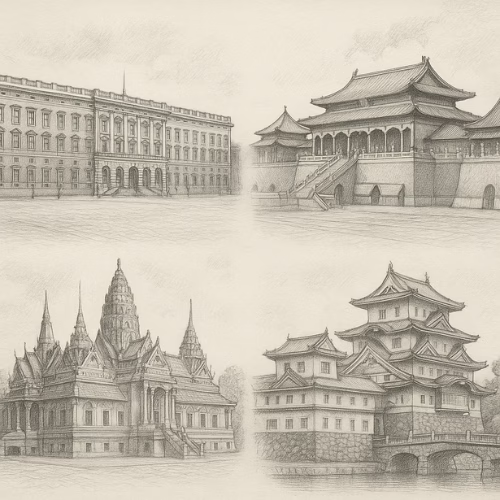The Royal Palace of Sweden doesn’t look like the kind of palace you’d expect. It’s not gold-drenched or gaudy. It doesn’t shout. It simply exists—dignified, symmetrical, stone-built, sitting atop Stockholm’s Old Town like it has nothing to prove. I stepped inside as just another visitor in a line of many, but with a mind full of ghosts and history.
I made my way down into the Treasury first, where the Swedish royal regalia is kept under thick glass and dim light. The crown was there—simple but sharp, its edges catching just enough gold from the spotlight. It wasn’t oversized or dripping with jewels. It didn’t try to impress. I stood there for a long time, longer than most tourists. Perhaps because I wasn’t looking at wealth. I was looking at restraint. This was royalty without indulgence. Power without arrogance.
Later, I crossed the water to Riddarholmen Island, where the Riddarholmskyrkan stands—a tall, gothic church with iron spires that scrape the sky. Inside, the air was dense with silence. This was where Swedish kings and queens, princes and princesses, had been buried for centuries. No golden tombs, no massive mausoleums with marble dragons or sapphire-eyed statues. Just a quiet church filled with crypts—modest chambers where generations of rulers rested side by side.
I moved slowly through the space, reading names I only half-recognized. Some of these monarchs ruled during centuries I hadn’t studied in years. But what caught my attention wasn’t the history. It was the structure. Each family had only a few children. One monarch, three children. Another, maybe four. Rarely more than five. Whole dynasties fit into corners of this church.
It stunned me. I had grown up with stories of emperors with dozens of wives, kings with fifty sons, rulers whose palaces had entire wings dedicated to concubines and their offspring. In Asia, particularly in China, Vietnam, or Cambodia, royal bloodlines multiplied across generations like an empire of names. I remembered visiting the Royal Palace in Phnom Penh once—it was breathtaking, enormous, drenched in gold, mirrored ceilings and lotus-carved columns, all while the people outside its gates lived with so little. And here, in one of the most developed countries in the world, the royal palace was smaller, plainer, more human. Even in death, these rulers made no spectacle of themselves.
Around me, other visitors whispered similar thoughts. I overheard someone say, “They really loved their people here. Look how modest they were.” And I thought about how, in much of Asia, kings ruled with extravagance while their citizens suffered. Thrones built on rice taxes. Tombs taller than temples. Dynasties that left behind more opulence than compassion.
In colonized lands like Indochina, things were worse still. There were puppet kings, figureheads who adorned themselves with European gifts while their own people starved. Even now, the aftermath of that heritage lingers in the architecture—in palaces that dazzle while the villages crumble.
But here, in Sweden, I sensed something different. A cultural value passed down through time: that power does not need to scream. That status is not something you parade in silk robes and golden bathtubs. I wondered whether this had always been the case or whether it was something learned, refined over generations.
I did some reading after, curious to know whether my impression about family size was accurate. It was. Swedish royals, particularly in the modern era, had fewer children, closer families. It wasn’t uncommon for a monarch to have two or three heirs at most. Nothing like the dozens and hundreds in imperial courts elsewhere. Perhaps it was intentional. Perhaps it was part of their governance—less about legacy in numbers, and more about maintaining balance. And perhaps that’s part of why Sweden feels so stable, so rarely shaken by excess or scandal.
As I walked back from the church, I found myself thinking not just about history, but about the difference between civilization and spectacle. In Asia, kings built palaces to prove their divinity. In Sweden, it seems they built theirs to remind themselves they were still human.
It’s strange to walk among tombs and feel a kind of admiration for those buried within. But I did. Not for their wealth or power, but for their restraint. For the fact that they could have had more—more gold, more children, more land—and didn’t. That, I think, is a greater legacy than any monument.
And perhaps, in the end, the real grandeur is the kind that doesn’t try to be remembered.



